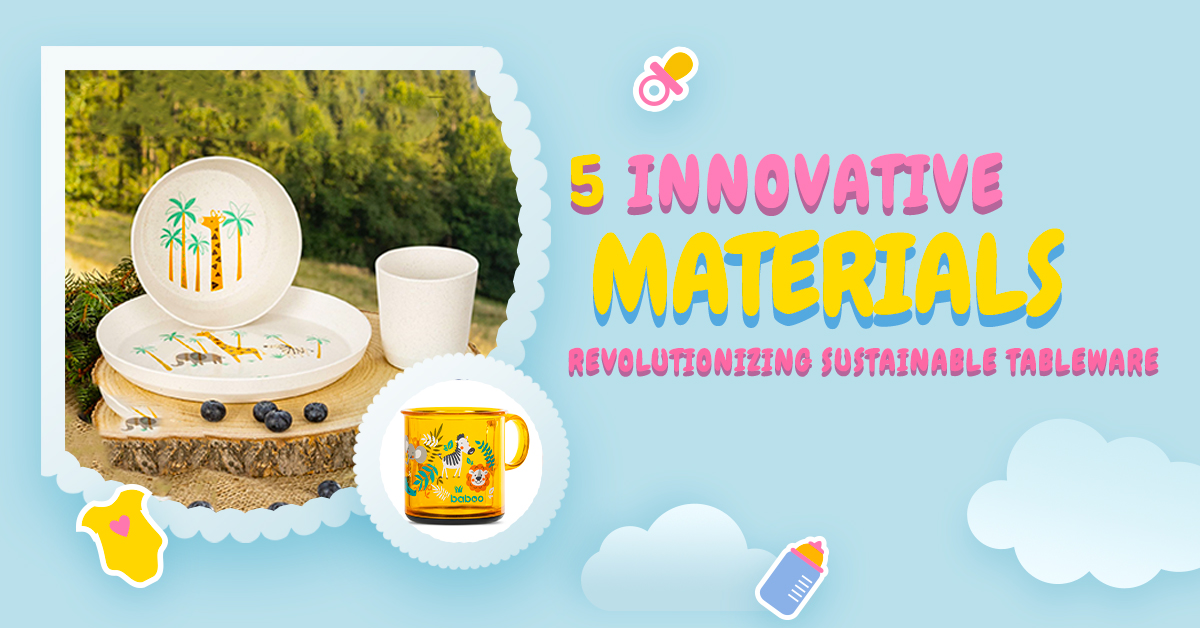

5 Innovative Materials Revolutionizing Sustainable Tableware
In today’s environmentally-conscious society, there’s a growing need for eco-friendly dinnerware to replace traditional plastics, driven by mounting concerns over plastic pollution. Innovative materials are leading the charge towards a sustainable future, especially in Sustainable Tableware for babies.
Beyond plastics, there are promising alternatives, especially when it is about babies. This blog will share such innovative materials used for making tableware for babies, keeping in mind their health and safety and also about less carbon footprint on Earth.
Bringing in sustainable tableware for babies is the key focus here. Biodegradable tableware is trending the most to make it more sustainable and eco-friendly.
What is Biodegradable Tableware?
Biodegradable Tableware includes cutlery and utensils made from various innovative materials that can naturally break down and decompose with time. These substances can be disposed of in the right composting conditions. Then they undergo microbial degradation.
They return to nature without leaving any harmful residues.
Functional Aspects of Tableware for Babies:
You should consider these aspects when selecting tableware for babies –
● You need to ensure that the tableware has no harmful chemicals and has no sharp edges. The safety of the baby is the primary requirement here.
● As babies keep dropping things every now and then, the tableware needs to be durable and hardy. This will prevent frequent buying of new ones.
● It is better to choose tableware materials which are dishwasher and microwave safe.
● Choose tableware which are bright and colorful to attract the babies and make mealtime easy and quick.
5 Innovative Eco-friendly and Sustainable Baby Tableware Materials
Bamboo Fibre:
Bamboo fibre is rapidly gaining popularity in the realm of sustainable tableware. It’s made from bamboo pulp, a fast-growing and renewable resource.
Bamboo tableware for babies is lightweight, durable, and biodegradable, making it an excellent choice for eco-conscious parents. Additionally, bamboo has natural antibacterial properties, ensuring a hygienic dining experience for little ones.
Cornstarch Polylactic Acid(PLA):
Derived from cornstarch, PLA is a bio-based and compostable material. It’s often used to create biodegradable tableware for babies, including plates, bowls, and utensils.
PLA offers the same functionality as traditional plastic but without the environmental drawbacks. When disposed of properly, PLA products break down into natural components, leaving behind minimal waste.
Wheat Straw:
Wheat straw, a byproduct of wheat production, is gaining traction as a sustainable material for eco-friendly dinnerware. It’s renewable, biodegradable, and free from harmful chemicals.
Wheat straw tableware is lightweight yet sturdy, making it ideal for little hands. By utilizing wheat straw, manufacturers are reducing agricultural waste while offering eco-friendly dinnerware for babies.
Sugarcane:
Sugarcane serves as a renewable source for bioplastic production, offering a sustainable solution for eco-friendly dinnerware. Extracting sugarcane juice initiates the process, followed by fermentation to produce lactic acid.
Polymerization converts lactic acid into polylactic acid (PLA), the biodegradable polymer used in bioplastic. PLA derived from sugarcane undergoes conventional manufacturing processes to create sustainable tableware for babies like plates and utensils.
Sugarcane-derived PLA is non-toxic, BPA-free, and resistant to bacteria, ensuring a safe and hygienic dining experience for infants. Its biodegradability reduces environmental impact, aligning with eco-conscious parenting values.
Recycled Plastic:
While traditional plastic is notorious for its environmental harm, recycled plastic offers a more sustainable alternative. By repurposing plastic waste, manufacturers can create eco-friendly dinnerware without the need for virgin materials.
Recycled plastic sustainable tableware is durable, lightweight, and easy to clean, making it suitable for everyday use. By supporting products made from recycled plastic, parents can contribute to the circular economy and reduce plastic pollution.
What Materials To Avoid?
When picking out biodegradable tableware for your baby, it’s essential to prioritize safety and eco-friendliness. Watch out for materials like:
● BPA,
● lead,
● cadmium,
● Teflon (PFAS),
● melamine plastic,
● phthalates,
● PVC, and
● petroleum products.
These are harmful materials which become more dangerous when exposed to microwave heat, UV rays, scratches, or hot food. To keep your little one safe, opting for tableware made from non-toxic and eco-friendly materials is important. Do your research to ensure you get the best choice for your child’s health and the environment.
Read More – DIY Natural Cleaning Solutions for Feeding Bottles and Nipples
Food Safety is the Priority
It’s crucial to ensure that the tableware we use keeps our baby’s food safe, especially when serving hot meals. Using food safe materials is essential. While using sustainable dining utensils, they should go through tests to get certified. The products should be ISO, FDA, GMP, ISI and BSCI certified.
Conclusion
Choosing biodegradable tableware is the need of the hour to reduce the carbon footprint on Earth. Using sustainable dining utensils even for infants and babies are important these days.
But all is possible only when it is safe for babies. So only edible and food safe materials should be used to avoid any hazardous situations. Using sugarcane, rice husk, wheat straw, cornstarch and recycled plastic, provides food safety and sustainability. These offer safeguarding both the babies and our Earth, where we live.

 April 26, 2024
April 26, 2024